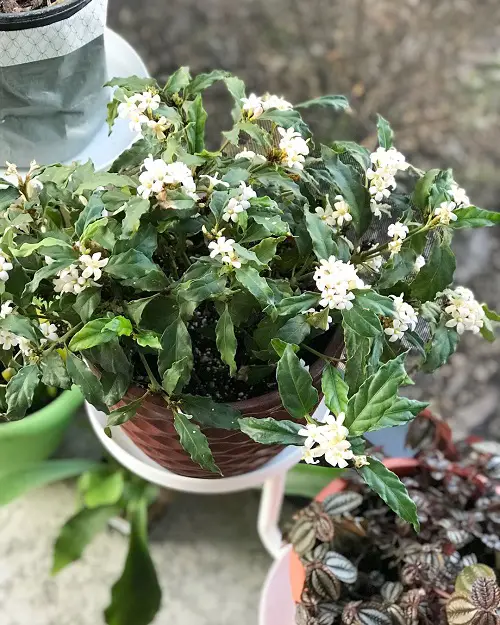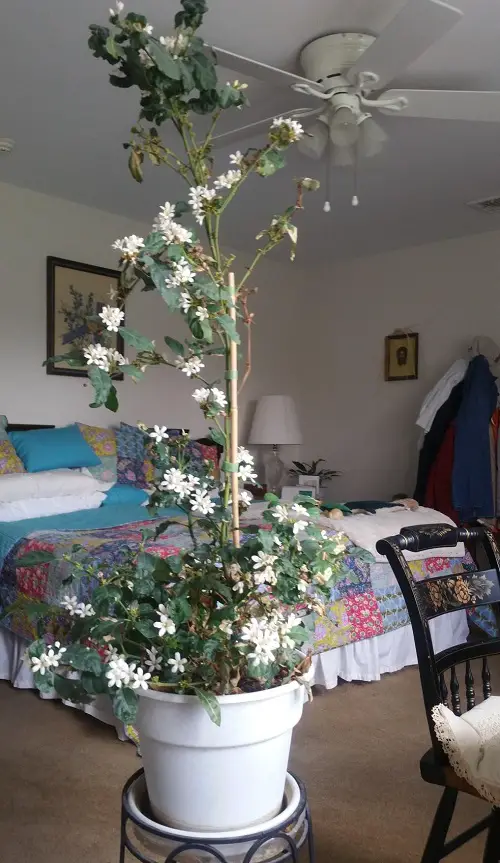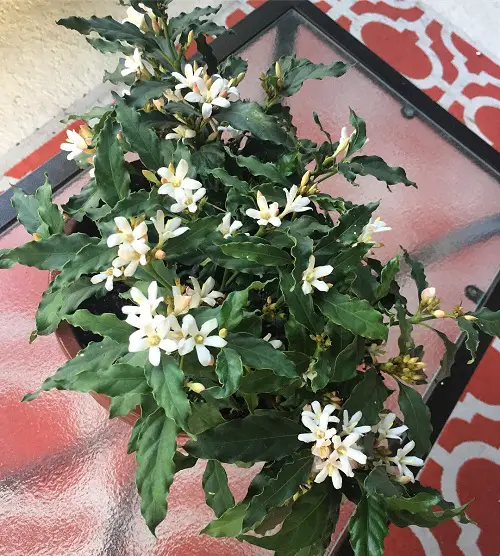Learn about African Gardenia Care and help this unique fragrant specimen thrive in your home garden! Read on!

If you want elegant white flowers with an intense scent to adore your garden, the African Gardenia can be a fantastic addition. Here’s everything you need to know about growing it.
Botanical Name: Mitriostigma axillare
USDA Zones: 9-11
African Gardenia Information
African Gardenia is a lovely flowering shrub native to the tropical regions of Africa. It is an evergreen shrub that can reach up to 4-6 feet in height with an upright and spreading form.
It features dense, glossy, dark green foliage. The fragrant white blooms appear in clusters at the end of the stems during the warmer months of the year. African Gardenias are easy to grow and require little maintenance.
The scent of flowers is a combination of jasmine, roses, and citrus, with undertones of vanilla, musk, and sandalwood.
Check out the Best Shrubs for Containers
African Gardenia Container Size
You can start African Gardenia in an 8-10 inches pot, which will be good for 2-3 years. Depending on the growth and spread, keep on re-potting it in a bigger container than the old one.
Propagating African Gardenia

To propagate African Gardenia, cut a healthy stem from the plant, remove the lower leaves, and dip the cut end in the rooting hormone. Plant the cutting in a small pot filled with moist, well-draining soil.
Place the pot in a warm, bright location and keep the soil moist but not soggy. After a few weeks, small roots should begin to form. Once the roots have grown and the plant is established, transplant it into a larger pot.
Here are the most Fragrant flowers you can grow
Requirements for Growing African Gardenia

Sunlight
African Gardenias need a minimum of 6 hours of sunlight per day. They prefer full sun exposure but can also do well with some partial shade.
Avoid keeping them in heavily shaded areas for prolonged periods, as this will reduce flowering.
Soil
The ideal soil pH range for African Gardenias is 5.5 to 6.5. The soil should be enriched with organic matter like compost or aged manure. For good drainage, it must have coarse sand or gravel.
Water
These plants like consistently moist soil, so water thoroughly and regularly, especially in summer when the growth is most active.
In winter, water only when the top inch of soil is dry. If overwatered, it can cause serious issues like root rot.
Temperature and Humidity
African Gardenia prefers warm temperatures ranging from 65-80°F (18-27°C). It will tolerate temperatures as low as 55°F (13°C) for short periods of time.
These plants prefer humid environments and should be kept in areas with high relative humidity, ideally between 50 and 70%. They should not be exposed to dry air, as this can cause the leaves to dry out and drop.
To increase the humidity around African Gardenia, mist the foliage daily or place the pot on a tray of wet pebbles. A humidifier can also be used to maintain the desired level of humidity.
African Gardenia Care

Fertilizer
Feed the African Gardenia a diluted balanced liquid fertilizer once every 5 to 6 weeks during the growing season. This promotes flowering. Also, make sure to avoid fertilizing in winter.
Nitrogen encourages healthy growth and blooming in African Gardenias. Phosphorus boosts root development and flower bud formation, while potassium improves vigor, growth, and roots.
Pests and Diseases
Though African Gardenias are easy to care for and low-maintenance plants, they can get pets and diseases like aphids, mealybugs, and whiteflies that damage leaves and flowers.
Additionally, diseases like powdery mildew and root rot might happen if the plant has been overwatered or has poor drainage.
To prevent such problems, plant African Gardenias in well-drained soil and water only when the top is slightly dry. Regularly check for pests or diseases and treat them immediately if found. Proper care will allow African Gardenias to thrive and showcase their beautiful blooms.



